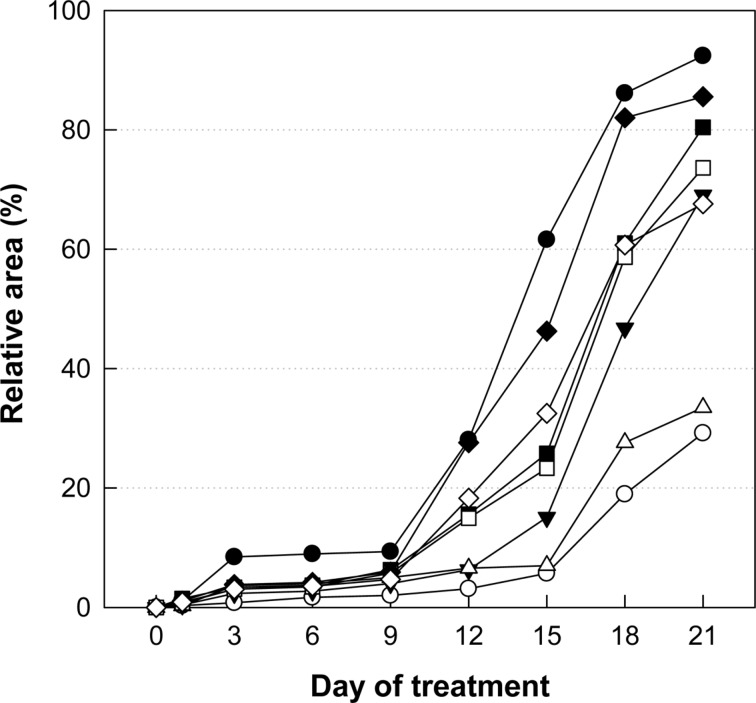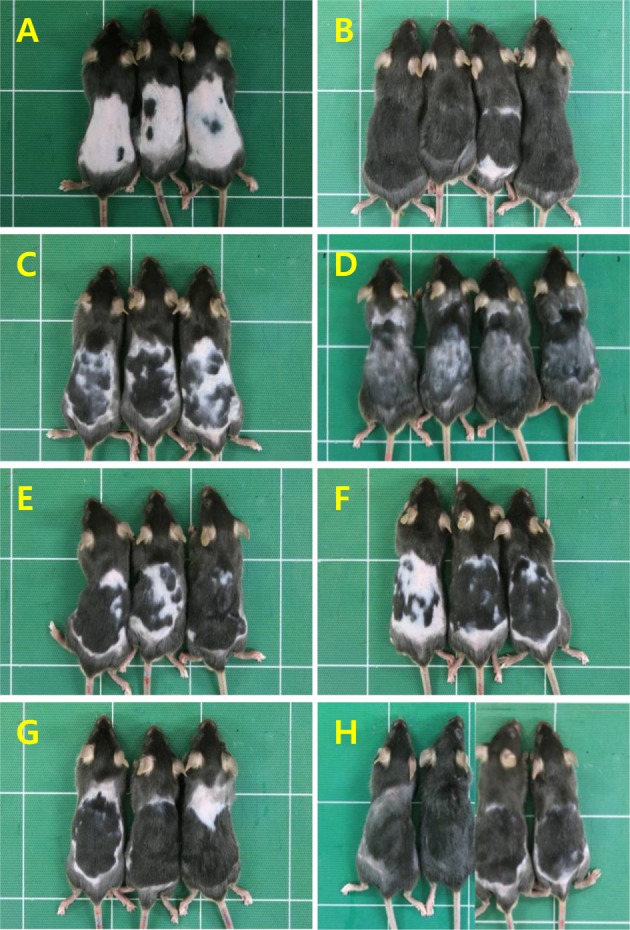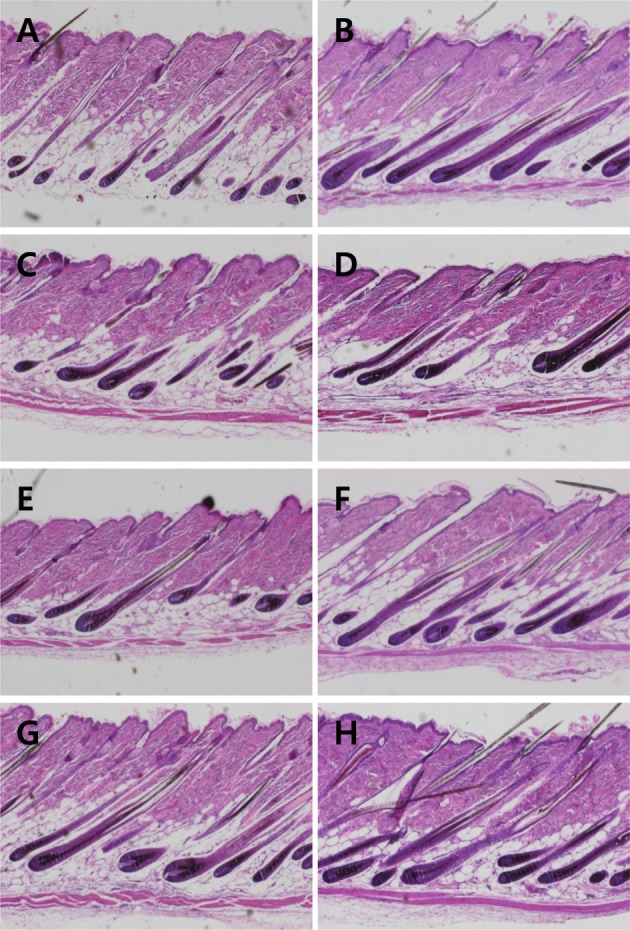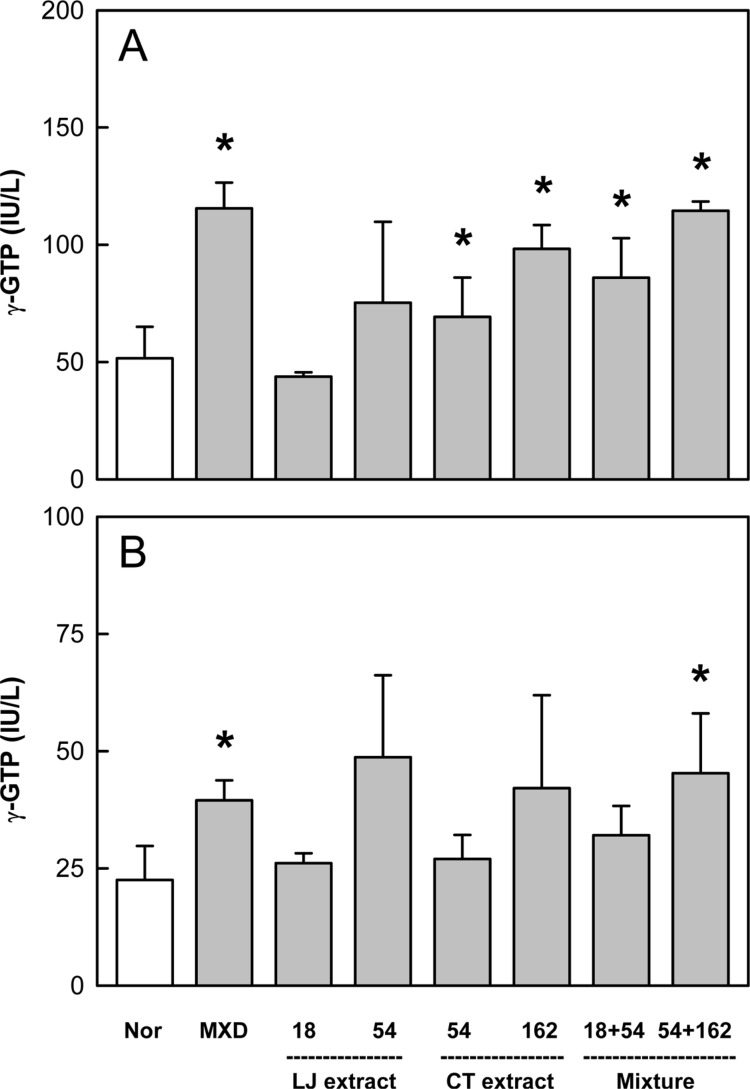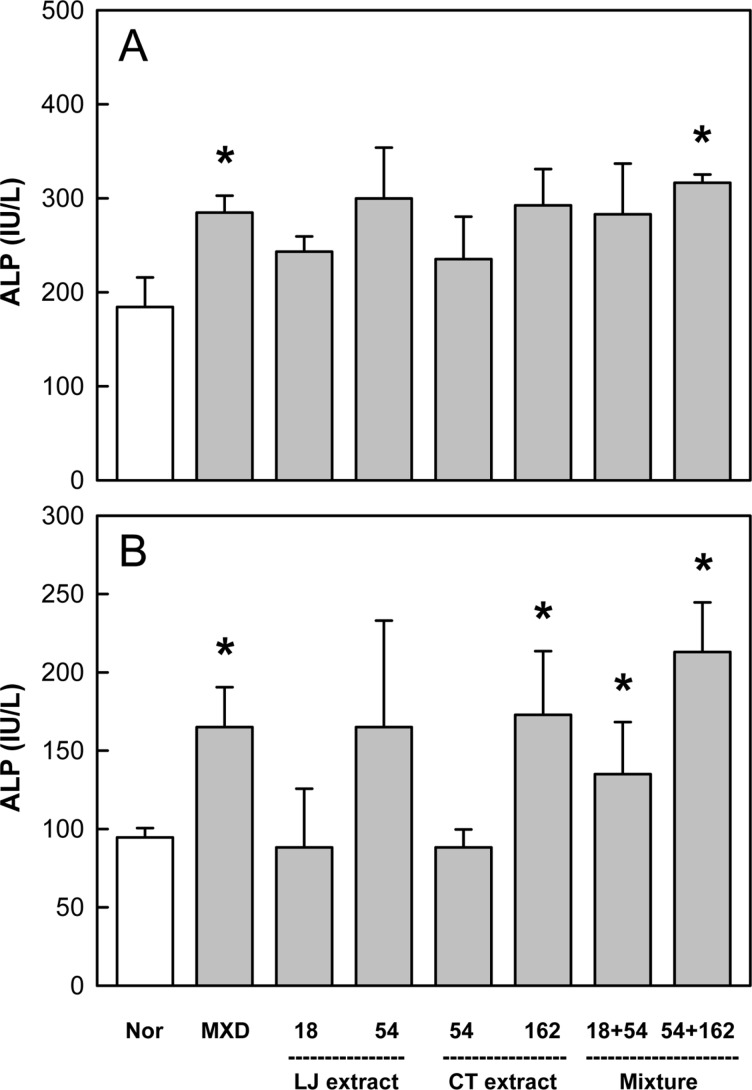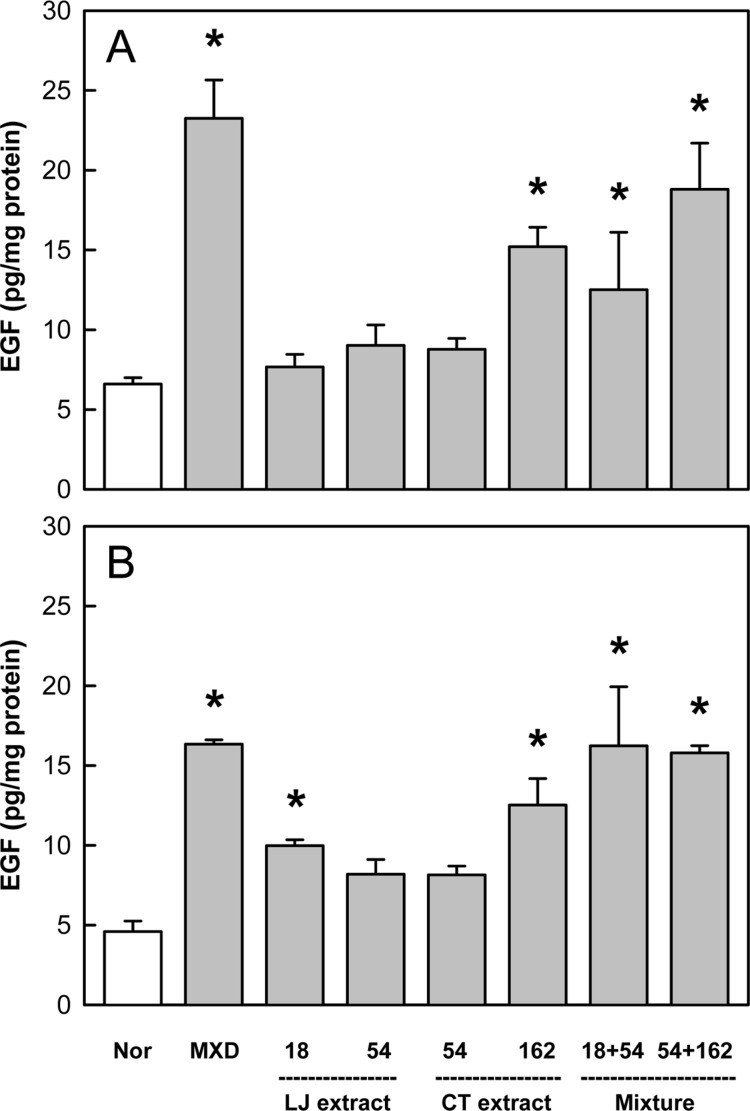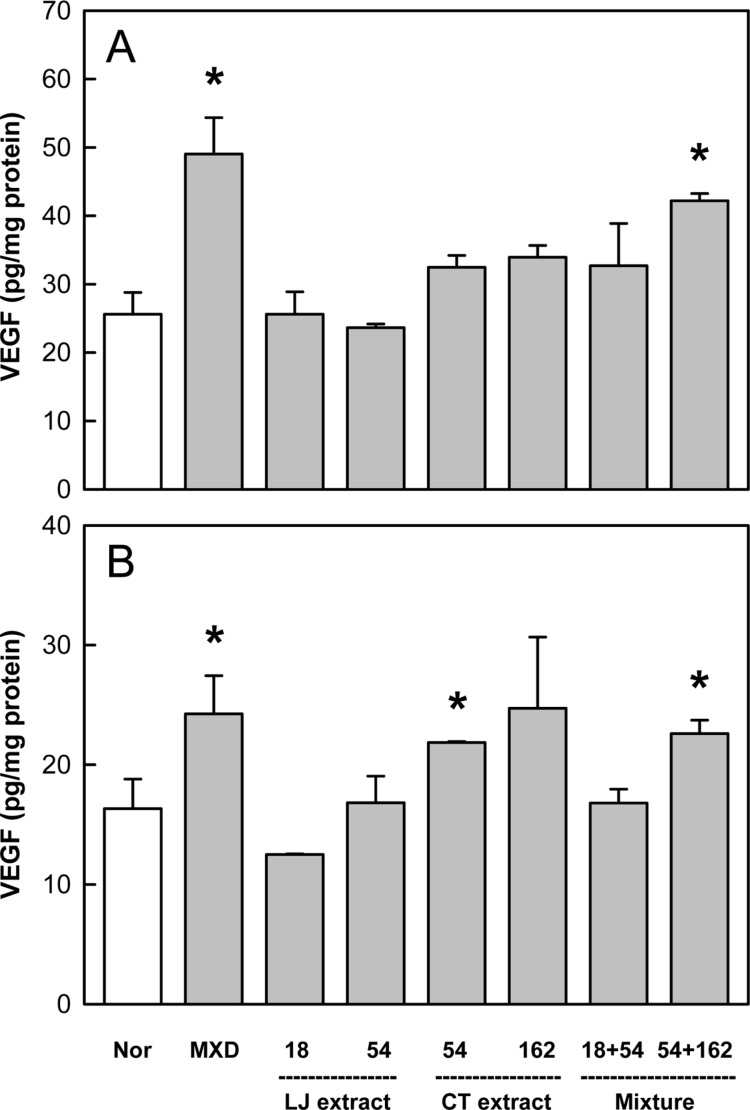Lab Anim Res.
2015 Mar;31(1):24-32. 10.5625/lar.2015.31.1.24.
Effectiveness of the combinational treatment of Laminaria japonica and Cistanche tubulosa extracts in hair growth
- Affiliations
-
- 1College of Veterinary Medicine, Chungbuk National University, Cheongju, Korea. solar93@cbu.ac.kr
- 2Misuba RTech Co., Ltd., Asan, Korea.
- 3Department of Food Science and Nutrition, Hoseo University, Asan, Korea.
- KMID: 1787648
- DOI: http://doi.org/10.5625/lar.2015.31.1.24
Abstract
- Since scalp hair loss has increased recently even in young people, seriously affecting individual's quality of life, the hair growth-stimulating effects of Laminaria japonica extract (LJE) and Cistanche tubulosa extract (CTE) were investigated. After confirming anagen phase of follicles under shaving, male C57BL/6 mice were dermally applied with 3% Minoxidil or orally administered with the combinations of LJE and CTE for 21 days. Minoxidil promoted the hair regrowth and increased gamma-glutamyl transpeptidase (gamma-GTP) and alkaline phosphatase (ALP) activities. In addition, Minoxidil up-regulated epidermal growth factor (EGF) and vascular endothelial growth factor (VEGF) levels. Co-administration of LJE and CTE at 54 mg/kg LJE plus 162 mg/kg CTE exerted synergistic promoting effects on the hair regrowth, comparable to 3% Minoxidil. LJE preferentially enhanced ALP activity, while CTE increased both gamma-GTP and ALP activities as well as EGF and VEGF expressions. In vivo air pouch inflammation model, carrageenan-induced vascular exudation and increased nitric oxide and prostaglandin E2 concentrations in the exudates were synergistically suppressed by co-administration of LJE and CTE. In addition, inflammatory cell infiltration was substantially inhibited by the combinational treatment. The results suggest that combinational oral treatment with LJE and CTE in appropriate doses and ratios prevent hair loss and improve alopecia, which might be in part mediated by their anti-inflammatory activities.
MeSH Terms
-
Alkaline Phosphatase
Alopecia
Animals
Cistanche*
Dinoprostone
Epidermal Growth Factor
Exudates and Transudates
gamma-Glutamyltransferase
Hair*
Humans
Inflammation
Laminaria*
Male
Mice
Minoxidil
Nitric Oxide
Quality of Life
Scalp
Vascular Endothelial Growth Factor A
Alkaline Phosphatase
Dinoprostone
Epidermal Growth Factor
Minoxidil
Nitric Oxide
Vascular Endothelial Growth Factor A
gamma-Glutamyltransferase
Figure
Reference
-
1. Kim JS, Kang BS, Park HJ, Kim DY, Hwang SY, Nam SY, Yun YW, Lee BJ. Promoting effect of herbal extracts mixtures on hair regrowth in C3H/HeJ mice. J Biomed Res. 2009; 10(3):99–108.2. Paus R, Cotsarelis G. The biology of hair follicles. N Engl J Med. 1999; 341(7):491–497. PMID: 10441606.
Article3. Cotsarelis G. The hair follicle: dying for attention. Am J Pathol. 1997; 151(6):1505–1509. PMID: 9403699.4. Cotsarelis G, Sun TT, Lavker RM. Label-retaining cells reside in the bulge area of pilosebaceous unit: implications for follicular stem cells, hair cycle, and skin carcinogenesis. Cell. 1990; 61(7):1329–1337. PMID: 2364430.
Article5. Oshima H, Rochat A, Kedzia C, Kobayashi K, Barrandon Y. Morphogenesis and renewal of hair follicles from adult multipotent stem cells. Cell. 2001; 104(2):233–245. PMID: 11207364.
Article6. Burton JL, Marshall A. Hypertrichosis due to minoxidil. Br J Dermatol. 1979; 101(5):593–595. PMID: 518830.
Article7. Meisheri KD, Cipkus LA, Taylor CJ. Mechanism of action of minoxidil sulfate-induced vasodilation: a role for increased K+ permeability. J Pharmacol Exp Ther. 1988; 245(3):751–760. PMID: 3385640.8. Buhl AE, Waldon DJ, Baker CA, Johnson GA. Minoxidil sulfate is the active metabolite that stimulates hair follicles. J Invest Dermatol. 1990; 95(5):553–557. PMID: 2230218.
Article9. Kaufman KD, Dawber RP. Finasteride, a Type 2 5alpha-reductase inhibitor, in the treatment of men with androgenetic alopecia. Expert Opin Investig Drugs. 1999; 8(4):403–415.10. Feldman SC, Reynaldi S, Stortz CA, Cerezo AS, Damont EB. Antiviral properties of fucoidan fractions from Leathesia difformis. Phytomedicine. 1999; 6(5):335–340. PMID: 11962540.
Article11. Wang J, Zhang Q, Zhang Z, Song H, Li P. Potential antioxidant and anticoagulant capacity of low molecular weight fucoidan fractions extracted from Laminaria japonica. Int J Biol Macromol. 2010; 46(1):6–12. PMID: 19883681.
Article12. Bojakowski K, Abramczyk P, Bojakowska M, Zwoliñska A, Przybylski J, Gaciong Z. Fucoidan improves the renal blood flow in the early stage of renal ischemia/reperfusion injury in the rat. J Physiol Pharmacol. 2001; 52(1):137–143. PMID: 11321507.13. Li N, Zhang Q, Song J. Toxicological evaluation of fucoidan extracted from Laminaria japonica in Wistar rats. Food Chem Toxicol. 2005; 43(3):421–426. PMID: 15680677.
Article14. Shimoda H, Tanaka J, Takahara Y, Takemoto K, Shan SJ, Su MH. The hypocholesterolemic effects of Cistanche tubulosa extract, a Chinese traditional crude medicine, in mice. Am J Chin Med. 2009; 37(6):1125–1138. PMID: 19938221.15. Yamada P, Iijima R, Han J, Shigemori H, Yokota S, Isoda H. Inhibitory effect of acteoside isolated from Cistanche tubulosa on chemical mediator release and inflammatory cytokine production by RBL-2H3 and KU812 cells. Planta Med. 2010; 76(14):1512–1518. PMID: 20354949.16. Kyung J, Kim D, Park D, Yang YH, Choi EK, Lee SP, Kim TS, Lee YB, Kim YB. Synergistic anti-inflammatory effects of Laminaria japonica fucoidan and Cistanche tubulosa extract. Lab Anim Res. 2012; 28(2):91–97. PMID: 22787482.17. Chee E, Fong KS, Al Jajeh I, Nassiri N, Rootman J. The association of lacrimal gland inflammation with alopecia areata. Orbit. 2015; 34(1):45–50. PMID: 25280049.
Article18. Brzezinska-Wcislo L, Bergler-Czop B, Wcislo-Dziadecka D, Lis-Swiety A. New aspects of the treatment of alopecia areata. Postepy Dermatol Alergol. 2014; 31(4):262–265. PMID: 25254012.19. Hattori M, Ogawa H. Biochemical analysis of hair growth from the aspects of aging and enzyme activities. J Dermatol. 1983; 10(1):45–54. PMID: 6134761.
Article20. Lee SH, Lee HJ, Baek IJ, Yon JM, Nam SY, Lee BJ, Yun YW, Kim YB, Hwang SY, Hong JT. Effect of DREAMMO® scalp lotion on hair growth promotion in an alopecia model of C57BL/6 mice. Lab Anim Res. 2006; 22(1):91–96.21. Handjiski BK, Eichmüller S, Hofmann U, Czarnetzki BM, Paus R. Alkaline phosphatase activity and localization during the murine hair cycle. Br J Dermatol. 1994; 131(3):303–310. PMID: 7918003.
Article22. Cross MJ, Dixelius J, Matsumoto T, Claesson-Welsh L. VEGF-receptor signal transduction. Trends Biochem Sci. 2003; 28(9):488–494. PMID: 13678960.
Article23. Shin S, Jeon JH, Park D, Jang JY, Joo SS, Hwang BY, Choe SY, Kim YB. Anti-inflammatory effects of an ethanol extract of Angelica gigas in a Carrageenan-air pouch inflammation model. Exp Anim. 2009; 58(4):431–436. PMID: 19654443.
Article24. Kim D, Park D, Kyung J, Yang YH, Choi EK, Lee YB, Kim HK, Hwang BY, Kim YB. Anti-inflammatory effects of Houttuynia cordata supercritical extract in carrageenan-air pouch inflammation model. Lab Anim Res. 2012; 28(2):137–140. PMID: 22787488.25. Rebora A. Pathogenesis of androgenetic alopecia. J Am Acad Dermatol. 2004; 50(5):777–779. PMID: 15097964.
Article26. Shirai A, Ikeda J, Kawashima S, Tamaoki T, Kamiya T. KF19418, a new compound for hair growth promotion in vitro and in vivo mouse models. J Dermatol Sci. 2001; 25(3):213–218. PMID: 11240269.
Article27. Kawabe TT, Kubicek MF, Johnson GA, Buhl AE. Use of gammaglutamyl transpeptidase activity as a marker of hair cycle and anagen induction in mouse hair follicles. J Invest Dermatol. 1994; 103(1):122–126. PMID: 7913117.28. Hamada K, Suzuki K. Evaluation of biochemical indices as a hair cycle marker in C3H mice. Exp Anim. 1996; 45(3):251–256. PMID: 8840142.
Article29. Park SJ, Lee KW, Lim DS, Lee S. The sulfated polysaccharide fucoidan stimulates osteogenic differentiation of human adipose-derived stem cells. Stem Cells Dev. 2012; 21(12):2204–2211. PMID: 22050637.
Article30. Danilenko DM, Ring BD, Pierce GF. Growth factors and cytokines in hair follicle development and cycling: recent insights from animal models and the potentials for clinical therapy. Mol Med Today. 1996; 2(11):460–467. PMID: 8947911.
Article31. Ozeki M, Tabata Y. In vivo promoted growth of mice hair follicles by the controlled release of growth factors. Biomaterials. 2003; 24(13):2387–2394. PMID: 12699676.
Article32. Fujie T, Katoh S, Oura H, Urano Y, Arase S. The chemotactic effect of a dermal papilla cell-derived factor on outer root sheath cells. J Dermatol Sci. 2001; 25(3):206–212. PMID: 11240268.
Article33. Stenn KS, Paus R. Controls of hair follicle cycling. Physiol Rev. 2001; 81(1):449–494. PMID: 11152763.
Article34. Chapman RE, Hardy MH. Effects of intradermally injected and topically applied mouse epidermal growth factor on wool growth, skin and wool follicles of merino sheep. Aust J Biol Sci. 1988; 41(2):261–268. PMID: 3270313.
Article35. Dvorak HF, Brown LF, Detmar M, Dvorak AM. Vascular permeability factor/vascular endothelial growth factor, microvascular hyperpermeability, and angiogenesis. Am J Pathol. 1995; 146(5):1029–1039. PMID: 7538264.36. Ellis RA, Moretti G. Vascular patterns associated with categen hair follicles in the human scalp. Ann N Y Acad Sci. 1959; 83:448–457. PMID: 13820052.37. Stenn KS, Fernandez LA, Tirrell SJ. The angiogenic properties of the rat vibrissa hair follicle associate with the bulb. J Invest Dermatol. 1988; 90(3):409–411. PMID: 2450148.
Article38. Yano K, Brown LF, Detmar M. Control of hair growth and follicle size by VEGF-mediated angiogenesis. J Clin Invest. 2001; 107(4):409–417. PMID: 11181640.
Article39. Lachgar S, Charveron M, Ceruti I. Distribution of VEGF mRNA indifferent hair follicle stages by fluorescence in situ hybridization combined with confocal laser microscopy. In : Van Neste DJJ, editor. Hair Research for the Next Millennium. Amsterdam: Elsevier;1996. p. 407–412.
- Full Text Links
- Actions
-
Cited
- CITED
-
- Close
- Share
- Similar articles
-
- Efficacy of Cistanche Tubulosa and Laminaria Japonica Extracts (MK-R7) Supplement in Preventing Patterned Hair Loss and Promoting Scalp Health
- Synergistic anti-inflammatory effects of Laminaria japonica fucoidan and Cistanche tubulosa extract
- Erratum: Synergistic anti-inflammatory effects of Laminaria japonica fucoidan and Cistanche tubulosa extract
- Comparison of Saccharina japonica–Undaria pinnatifida Mixture and Minoxidil on Hair Growth Promoting Effect in Mice
- Comparative analysis of anti-Helicobacter pylori activities of FEMY-R7 composed of Laminaria japonica and Oenothera biennis extracts in mice and humans

